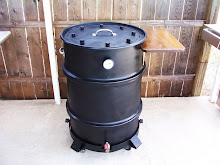Here is an easy way to cook whole hogs from 50 to 150lbs. without an expensive cooker. Cinder block pits are easy to use, cheap and portable. You have the option to use your favorite wood chips for flavoring, mesquite, hickory, fruit woods, whichever you like, or no wood chips at all.
Also you can season the pork with dry rub or marinade for a few hours or overnight. The choice is yours
Pigs cooked on the cinder block pit come out so tender and juicy. A must try for the person that enjoys cooking outside or cooking for a large group.
Things you will need.....
30 cinder blocks, 35 to 50lbs charcoal, wood chips (hickory, mesquite, or your favorite), rake or hoe, foil, drip pans, tin to cover, bricks to hold down tin, grate or expanded metal........Also, one nice looking 50 to 125lb pig.
Skin the pig or scald and scrape.
This one was skinned, head and feet removed.
Using an axe and a hammer, butterfly the pig so that it will lay flat on the cooker.
Place the blade of the axe on the spine, use the hammer to tap the back of the axe head, splitting the spine. If you do this on a pig that you have scalded and scraped, do not cut into the skin.
Tap the axe and repeat until you've split the length of the spine. Press the shoulders and legs to make the pig lay flat.
I made a marinade of orange juice, lime juice, garlic cloves, coarse salt, fresh ground black pepper, oregano and cilantro.
Make 1" slits into the meat with a knife and shove the garlic cloves and spices into the openings.
You can use your favorite marinade or skip this step completely. Also, dry rub is a good option.
Cover the pig with ice and let it marinade overnight.
If you want to skip this step, just chill the meat for a few hours before cooking.
Pick an area that has no grass. Set the cinder blocks up two rows high.
I line the bottom with foil to channel some of the dripping grease away from the heat to avoid flair ups.
You can add drip pans in the bottom if you like, these are optional. I filled my drip pans with apple juice seasoned with my favorite dry rub to add extra flavor to the meat while cooking.
Go ahead and light your charcoal, about 5lbs at each end of the pit. The charcoal goes under the hams and the shoulders only. Do not place any charcoal under the rib section of the pig. The heat from the coals under the hams and shoulders is enough to cook the whole pig.
After placing your foil and drip pans in the bottom, lay the grate across the blocks. Stainless is great, but any grill works good.
Add a third row of cinder blocks around the edge, (a fourth row if your pig is too tall to cover), place pig on the grate and cover with tin.
Keep a rake or hoe handy to move coals around if needed.
Place the pig on back side first, then turn on it's belly half way through. This one is ready to turn.
The whole cinderblock pit is covered with metal and held down with bricks if you live in a windy area.
One thing about the metal..... Do not used galvanized metal when cooking. In this case the cooker does not get hot enough to make any difference, but if you are cooking with a hot fire, the galvanized metal could give off fumes that could make you ill.
If you have nothing BUT galvanized metal, burn it with a blow torch or weed burner before using.
Add charcoal to each end of the cooker every 1 1/2 to 2 hours. Move an end block to allow room to throw 10 to 15 pieces of charcoal on top of the hot charcoal at each end. You do not need to have these fresh charcoals lit, the heat of the burning charcoals will light them. (you can burn wood in a separate pit and add those instead of charcoal)
You can also add soaked wood chips ( your favorites), while cooking. You do not need to add them every time you add charcoal, it will make the pork too smokey. Add a handful three or four times during the first few hours of the cooking process.
I used hickory on this one.
Half way through cooking time, remove tin, grab the legs and turn pig onto it's belly side.
This usually takes two people and gloves make the job a lot easier. The pig only needs to be turned once through the whole cooking process.
Check the rib section. If it's cooking too fast, cover with foil to keep from over cooking.
Cover and finish cooking.
Let the meat rest for at least 20 minutes to equalize the juices. Move to serving table or plywood covered in foil and dig in. Serve your favorite sauces on the side.















































